Exploring Amazing Deserted Places
Deserted locations are often anything but, despite their sometimes chilly and bleak appearance. When people depart, nature takes over, turning abandoned Italian flour mills into verdant oases and shipwrecks into flooded forests.
In some respects, the power of Mother Nature makes deteriorating antiques seem even more amazing than they once were. Only a slight reminder of our existence remains after abandoned structures are finally absorbed by the vegetation and, in certain situations, the earth itself. Ten such abandoned locations that have been reclaimed by Mother Nature and provide a window into a world free from human intervention were found by us.
Related: Famous Religious Architectural Marvels
Amazing Deserted Places No10: Ta Prohm, Cambodia’s Angkor Wat
Of the many temples found in Angkor Wat, the Ta Prohm temple is, without a doubt, the most well-known and largest. Massively overgrown tree roots have covered the temple’s crumbling walls. King Jayavarman VII oversaw the Angkor Wat construction project, which got underway in the 12th century. The majority of the passages of this Buddhist temple are now mostly impassable due to the massive banyan tree roots that have twisted their way through the walls and protruding ground.

Nonetheless, Ta Prohm remains accessible to the general public and is visible from the courtyards. Some areas of the park, like the well-known Crocodile Tree (which was prominently featured in the movie Tomb Raider), have been marked off for preservation by visitors. Ta Prohm is a prime example of the Ancient Khmer Empire’s amazing engineering. The temple has nearly completely been overtaken by the surrounding forest now, with the old walls being absorbed by its roots and vegetation.
Amazing Deserted Places No9. The Mexican town of San Juan Parangaricutiro
In the western Mexican state of Michoacan, the remains of a church mark the location where the community of San Juan Parangaricutiro flourished until it was destroyed by ash and lava from the Paricutin Volcano, one of the world’s youngest volcanoes. The town of Herculaneum and numerous other settlements, including Pompeii, were destroyed when Vesuvius erupted in southern Italy in AD 79. Similarly, when Paricutin erupted in 1943, it destroyed San Juan Parangaricutiro and the village from which it got its name.
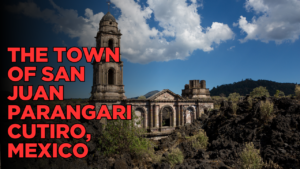
There were no casualties during the spectacular eruption of the Mexican volcano, in contrast to the enormous Italian volcano, which probably killed thousands when it erupted. Fortunately, locals were able to evacuate before the lava started to pour into the settlement a few days later. The only remaining parts of the church, bell tower, part of the facade, and altar remain in the barren, lava-covered area that is now a tourist destination, San Juan Parangaricutiro. When locals come to light candles and pray, they still use all of those that have survived.[2]
Amazing Deserted Places No8: Bangkok’s New World Shopping Mall in Thailand
The Bang Lam Phu district of Bangkok is home to the run-down and abandoned New World Mall, which was constructed in the early 1980s. But it only existed for 15 years before permanently closing. Its history of disasters, including fires, collapses, and uncontrolled building of its top stories, is one of the many reasons for its demise. The mall was taller than the nearby Grand Palace because of its upper floors. Because it is a “no-no” in the area to erect structures taller than this highly cherished and historic landmark, this infuriated the locals.

Nearly 465 square meters (5,000 square feet) of completely flooded area remained on the bottom floor after the upper levels were partially removed, leaving the building roofless. This led to a significant mosquito outbreak, which caused the neighborhood to become quite concerned. In order to combat the mosquito invasion, vendors and locals decided to handle the issue themselves and started tossing fish into the pond. As a result, the number of fish increased over time. There were once about 3,000 koi, striped catfish, mango fish, and other species in the strange habitat.
Around 2015, the tale of the “deserted fish mall” gained international attention and eventually made headlines. Regretfully, the fish were ultimately gathered using nets in order to drain the pond later owing to safety concerns.
Amazing Deserted Places No7: India’s Ross Island Penal Colony
There are more than 500 little islands that make up the Nicobar and Andaman Islands. The name Ross Island is one of these. In order to safeguard and confine a sizable number of prisoners from the Indian Rebellion of 1857, the British government in India started using the island as a prisoner settlement around the 1850s. The British built a number of facilities and residences at the site while also establishing the prison colony and designating it as the administrative hub for the entire group of islands.

A massive earthquake that shook the region in 1941 claimed the lives of thousands of its residents. After that, the island was occupied by the Japanese, who utilized its advantageous location as a refuge throughout World War II. After the war, India regained possession of the bunkers that had been built to protect the Japanese forces. The Indian Navy now controls Ross Island once more. It was once teeming with people, but today, it is completely overrun by jungle vines and abandoned.[4]
Amazing Deserted Places No6: The Namibian town of Kolmanskop
Ten kilometers (6.2 miles) from the Namibian coast, German mining companies arrived in the early 20th century on a portion of the Kalahari Desert that was only accessible by a small railway station. By 1912, when Namibia was ruled by Germany, Kolmanskop, the hamlet that sprang from the sand, would produce 12% of the world’s diamonds. The tiny mining town was transformed from a dilapidated collection of wooden buildings to an impressive example of European architecture, complete with a music hall and a lovely bar.

However, the dunes pushed in, and the fortune-seekers left when they discovered richer diamond sources further south. The Namibian desert’s dry, windy climate causes a lot of sand movement. Between 1955 and the 1960s, the village’s last residents departed, leaving the charming tiny settlement vulnerable to Namibian sandstorms. Consequently, the sand started to accumulate in the elaborately carved buildings, leaving us with nothing more than artifacts from a past time that the dunes eventually took back.
Amazing Deserted Places No5: Sorrento, Italy’s Valley of Mills
When one thinks about Italy, one immediately thinks of its breathtaking architecture, exquisite wines, amazing artwork, and breathtakingly gorgeous seaside villages. Sorrento is an Italian town that many people are not familiar with, yet Vernazza, Sperlonga, and Scilla may come to mind. With breathtaking views of the Bay of Naples, the village is perched on a rock. Another well-known (and delectable) liquor that originated in Sorrento is Limoncello. Some amazing lesser-known locations should not be missed despite the abundance of activities in and around Sorrento.
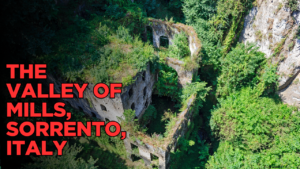
The town’s main center is just a short stroll from a historic, abandoned flour and sawmill. Once the bustling center of the area’s pasta-making operations, the old stone buildings of Il Vallone dei Mulini, also known as the Valley of Mills, are now hidden behind dense vegetation. The charm of the old mill is hard to resist once you’ve seen it. The mill itself, the roads around it, and the stairwells are all overrun with vegetation. The profusion of wild ferns and vines, which resemble a fairytale tower in a mythical world, greatly heightens the spooky ambiance of mystery and lost tales.
Amazing Deserted Places No4. China’s Houtouwan Fishing Village
The bustling streets of Shanghai on the mainland are less than 100 kilometers (62 miles) away from the fishing town of Houtouwan, which is situated on an island in the Shengsi archipelago. In the 1990s, residents started to depart the village, and within 30 years, Houtouwan was entirely covered with jungle. Remarkably, just ten years before it was abandoned, it had 3,000 residents and was a fishing hamlet. Fishermen relocated their families to the mainland when the island’s seafood supply ran out, and some of them eventually returned to show tourists around.
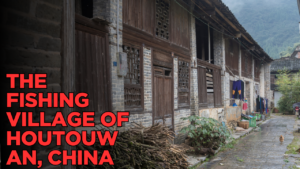
Only daring travelers visit the island these days. The ancient and abandoned homes, which frequently have a museum-like feel to them and include artifacts from the past, like furniture and household goods, are popular with tourists. Unfortunately, because the plant life has accelerated the constructions’ eventual deterioration, some of the structures are considered dangerous to examine, and residents have had to erect warning signs.
Amazing Deserted Places No3: Canada’s Carbide Willson Ruins in Quebec
The Carbide Willson remains are well known to many visitors to Gatineau Park, but they might not know who constructed them. With more than 70 patents, Thomas Leopold “Carbide” Willson, who was born in Woodstock, Ontario, in 1860, was a pioneer in the electrochemical sector in North America. The main reason for the inventor’s notoriety and moniker “Carbide” is because, while working in the United States in 1892, he discovered a method for 2. reducing calcium carbide. As is frequently the case, a string of fortunate events led to this finding.
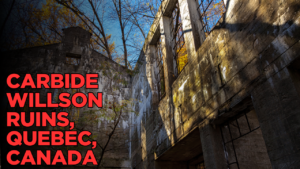
Despite acquiring a plot of land in the early 1900s, Carbide passed away before his construction project was accomplished. Hence, it was never constructed. The building’s empty shell, which offers us a glimpse of its potential magnificence, is all that is left of it now. Instead of being windows, the many empty areas have been woven into the park’s winding greenery. Nature’s invasion is completed by a waterfall that is located directly next to the building.[8]
Amazing Deserted Places No2: Kayakoy’s Ghost Village in Turkey
Kayakoy is a small village next to the well-known resorts of Fethiye and Olu Deniz. It is, however, barren and lifeless. The streets are empty, and its residences are crumbling. But at the turn of the nineteenth century, Kayakoy was thriving. The village was actually thriving, with shops, companies, churches, and schools all thriving. The fact that Greeks and Turks coexisted inside the town is the strangest and most significant aspect of its history. These two different ethnic groups led an integrated life outside of their values and education, and everyone merely wanted to live a respectable life.
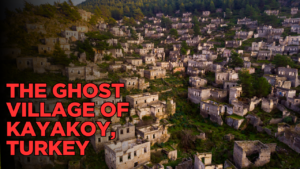
The Ottoman Empire’s demise, the First World War’s defeat, and the Greek annexation attempt in the Anatolian region were among the historical events that befell Kayakoy. The last nail in the coffin, however, was definitely the signing of the Turkish-Greek Population Exchange Treaty. In essence, Muslim Turks were expelled from Greece, and Greek Christians were exiled from Turkey. Eventually, the few people who were left left when an earthquake occurred. As is still the case in many other nations and communities worldwide, Kayakoy’s citizens were ultimately utilized as pawns in a bigger game conducted by higher forces.
Amazing Deserted Places No1: Ukraine’s Chernobyl Exclusion Zone
A cloud of radioactive particles spread around Europe in April 1986 as a result of an accident at a nuclear power facility in Chornobyl, Ukraine (then a part of the Soviet Union). It is currently regarded as the world’s worst nuclear accident. Three hundred fifty thousand people had to be evacuated from the exclusion zone, which is the area around the nuclear power plant, with little time to be ready. Because of this, a lot of houses, offices, and schools are still in the same condition as when their owners left.

Because of HBO’s terrifying portrayal of the nuclear accident and its horrific aftermath, tourists are now more interested in the Chornobyl Exclusion Zone than they were before. The abandoned Ukrainian town of Pripyat is definitely worth considering while discussing the world’s abandoned locations. On our agenda today, though, is the exclusion zone, which became accessible to the public in April 2019. Here, wolves, lynxes, brown bears, and an estimated 200+ bird species are among the abundant wildlife. The streets and houses are surrounded by greenery and plants, demonstrating that life will always find a way.
Weirdest Places That Have Been Preserved
Many ancient sites, including George Washington’s Mount Vernon and the Tower of London, have been conserved over the years, but it is frequently unexpected to learn about some of the historical sites that have been kept open for visitors to explore. These locations can be very popular tourist destinations, regardless of whether they are associated with a startling crime or an unusual incident. These ten locations rank among the most bizarre historic sites that should be conserved.
Weirdest Places No10: The Witch House
A horrifying and terrible period of colonial American history was the Salem Witch Trials, which frequently led to the execution of numerous people. Nonetheless, the tales of these individuals being charged with witchcraft continue to pique people’s curiosity hundreds of years later. The final structure still standing that is closely connected to the well-known Salem Witch Trials of 1692 is reportedly the Witch House in Salem, Massachusetts. Additionally, the public can access it.
The Corwin mansion, a big, foreboding gray clapboard mansion with lattice windows, was formerly the residence of Judge Jonathan Corwin (1640–1718), one of the two judges who examined accused witches in this period. Corwin, a fervent witch hunter who came under fire for using spectral evidence to support convictions, was also personally involved in the witch issue.
It was thought that one of Corwin’s children was affected by the witchcraft outbreak, and his mother-in-law was charged with witchcraft but never arrested. In the 1940s, it was in danger of being demolished to make room for a road, so residents donated funds to have it moved back 35 feet (10.6 meters). It provided an insightful look into the everyday lives of the wealthy class in 17th-century New England when it opened as a museum in 1948.
Weirdest Places No9: Bodie, California
In the Sierra Nevada Mountains, the once-thriving gold mining town of Bodie, California, is now regarded as a ghost town, although it comes alive during the tourist season. Almost entirely deserted by the 1940s after a gold rush in 1875, Bodie was designated a State Historic Park and a National Historic Landmark in 1962. Bodie is thus kept in a condition of “arrested decay.”
The fact that so many personal goods were left behind in this specific ghost town is one of its most intriguing features. This is mostly because inhabitants found it too costly to have their belongings removed when they relocated due to the location’s difficulty. Bodie has a more eerie and surreal feel than a normal ghost town because of the discovery of antique furniture inside the deserted houses and other relics of everyday life, including a roulette wheel inside the saloon, which gives the place the appearance of being trapped in time.
Weirdest Places No8: The Castle of Franklin
The Tiedemann House, also known as Franklin Castle, is a haunted house on Franklin Avenue in Cleveland that has a rich and colorful past. In the early 1880s, Hannes Tiedemann, a wealthy local businessman who had moved from Germany, constructed the expansive, stone Victorian eclectic building.
The house served as temporary housing for friends, family, and recently arriving German immigrants, in addition to being a place of abode for Tiedemann and his family. Later, the German-American League of Culture called it home. Since then, it has been owned by several persons, notably Mickey Deans, a singer and Judy Garland’s sixth husband, who made significant investments in the house’s restoration. More renovation followed an arsonist’s fire shortly after Deans sold it in 1999.
One owner capitalized on the public’s interest by providing haunted house tours in the mid-1970s after tales had been circulating for a number of years. The tragedy that the Tiedemann family experienced while residing on this land was one factor that contributed to the continuation of the ghost story.
Weirdest Places No 7: South Dakota’s Minuteman Missile National Historic Site is located close to the Wall.
The Minuteman Missile National Historic Site gives visitors a glimpse of what life was like in a location that was crucial to the Cold War. When more than 1,000 Minuteman missiles were buried around the United States during these years, teams would sit in launch command centers like this and watch classified frequencies, ready to strike the enemy at any time.
The launch center’s small and uninteresting surroundings stand in sharp contrast to the terrifying purpose for which it was built. Since it was shut down in the middle of the 1990s, this location has been remarkably conserved. With the old coffee maker still in the snack area and reading materials like Byte Magazine and very old copies of Reader’s Digest, which were once used to help cope with what must have been tedious hours in this impenetrable bunker 80 feet (24 meters) underground, the center is part nostalgia in addition to all the sophisticated equipment.
Weirdest Places No6: Baltimore’s Stavros Niarchos Foundation Parkway
Many moviegoers today perceive the Stavros Niarchos Foundation Parkway, a 1915-built movie theater in Baltimore, as being run-down or incomplete. It is meant to have the same appearance as when it was abandoned in 1978, even though $19 million was spent on preservation. This is due to the attempts to keep this movie theater in a suspended state of degradation in the manner of the Renaissance Revival.
A few relics from the theater’s history, including the different wallpaper pieces that depict different decades, offer insight into how the theater has changed over time. Architect Steve Ziger met with his buddy, Maryland Film Festival director Jed Dietz, many years after the city had taken ownership of the building. In order for the obvious alterations the venue had undergone to speak for itself, they came up with the notion of updating the structure to code while mostly leaving it intact.
George Arendt, senior project manager at Southway Builders, expressed amazement at this idea, saying, “I thought, ‘Wait, they just want to leave it as-is?'” Chipped plaster, faded and mismatched paint, missing ornaments, and a ruined sunburst medallion are just a few of the many signs of the collapse.
A new marquee was constructed to replace the old one that was demolished in 1980, although Steve Ziger made an effort to avoid duplicating things that were no longer there. The final effect may be a unique setting for film screenings, but visitors can also experience a journey through history by visiting this iconic theater, which reopened in 2017, in addition to the escapism that comes with going to the movies.
Weirdest Places No5. Alcatraz
Normally, it might seem strange to keep an abandoned jail as a museum, but the history of Alcatraz, which is situated on a small island off the coast of San Francisco, is incredibly fascinating. Alcatraz Island had other uses long before the famous federal prison, which was operational from 1934 to 1963. It was home to the first lighthouse on the Pacific coast, a fort constructed in the early 1850s, and a military prison. Before it joined the National Park Service and opened to the public in 1973, it was also occupied by Native Americans from 1969 to 1971.
But what people most remember it for is the maximum security jail called “The Rock,” which attracts a lot of tourists. Curiosity about this legendary former correctional facility has been fueled by the infamous criminals who served time there, as well as by well-known escape attempts and films. The main cell block has been remarkably well preserved, providing visitors with a genuine impression of what the living circumstances were like for convicts there, despite several areas of the complex being damaged by graffiti and fire.
Weirdest Places No4: Glore Mental Health Museum
We can better appreciate why people used to be afraid of mental hospitals after visiting the Glore Psychiatric Museum. When it was opened in 1874, this old mental hospital in St. Joseph, Missouri, was called the State Lunatic Asylum #2. Replicas of torturous tools are on exhibit in addition to the tools used at this facility, including “restraining belts, ‘early tranquilizers’ (clubs), electroshock superchargers, and doctor-designed ice picks for lobotomies.” Situated outside the old hospital, which has been transformed into a correctional prison, these provide a somber glimpse into the past of mental health treatment. They are housed in the hospital’s former surgical and outpatient building.
Hobbies or pastimes of the asylum’s former patients are among the most fascinating exhibits. In addition to the patient-made artwork, there is a display of 108,000 cigarette packets that a male patient gathered with the intention of using to purchase a new hospital wheelchair. One glass cabinet contains 1,400 different metal things that were swallowed by a woman who had a compulsive need to swallow metal objects, such as buttons, bolts, screws, pins, nails, and bottle caps.
Weirdest Places No3: Death Valley
The scorching, arid Death Valley National Park, located near the California-Nevada border, is known for its harsh environment and has locations like Furnace Creek and Devil’s Hole. It is not surprising that many people considered this area to be a vast wasteland, except for its potential for mining. But 3.3 million acres became a national park in 1994 when the California Desert Protection Act was passed.
Rare plant and animal species are among the many items in this frequently harsh environment that should be preserved. The formidable Death Valley has managed to preserve its natural resources while also retaining some interesting artificial landmarks, like Marble Bath, which is literally a large claw-footed bathtub filled with marbles. It was brought to this sweltering region of the Mojave Desert by someone who must have had a sense of irony.
A signpost at Teakettle Junction is also adorned with a large number of tea kettles that tourists have left there. Ghost towns and industrial remnants, such as the 19th-century Borax Works and, perhaps most unexpectedly, a 1920s vacation home known as Scotty’s Castle, are among Death Valley’s most visited sights.
Weirdest Places No2: The Reformatory at Ohio State
The Ohio State Reformatory’s preservation was made possible in large part by local activists. The former prison has been maintained, repaired, and restored by volunteers since it was purchased from the state for $1.00. In addition to becoming a popular tourist destination, the site was used for filming The Shawshank Redemption, a popular film released in 1994, during the first few years after it was closed in 1990. Scenes from several other films, such as Air Force One and Tango and Cash, were filmed there.
Because its convicts were too old for juvenile correctional facilities, the 1896 establishment in the Mansfield area was first known as the Intermediate Penitentiary. However, their offenses were not as serious as those of those sent to the Ohio State Penitentiary. The Romanesque-style limestone building’s elegant architecture contributes to its allure for filmmakers. In order to provide OSR with a design that would be “uplifting, inspiring, and intimidating,” architect Levi Scofield was successful. OSR’s reputation for being haunted is another element that draws tourists there. Special ghost tours are even available at the location.
Weirdest Places No1: House of Lizzie Borden
The location of a notoriously violent double murder may seem like a strange choice for a place as conventionally peaceful and welcoming as a bed and breakfast, yet that’s precisely what happened to suspected killer Lizzie Borden’s former residence. When Mr. and Mrs. Borden were killed with a hatchet in 1892, Borden, a 32-year-old Sunday School teacher from a well-to-do and well-respected family, was living in this home in Fall River, Massachusetts, with her father Andrew, stepmother Abby, and older sister Emma (who was then on vacation). Despite her acquittal, Lizzie Borden’s involvement in this unsolved murder has continued to be widely believed over the years.
The Lizzie Borden House, which is now a museum and bed and breakfast, is in excellent condition and provides a variety of excursions, including a ghost hunt. The house still has its original hardware and doors, but the decor has been replicated. Artifacts related to the unique case are also on display at the location.

